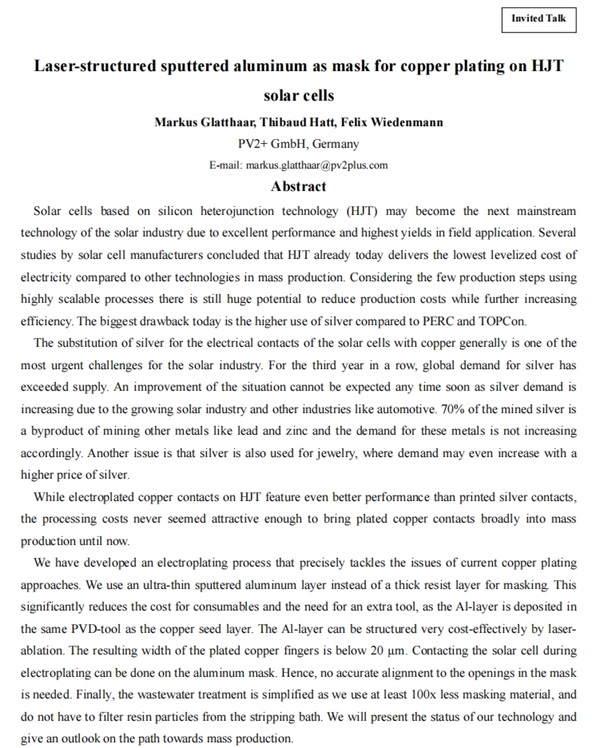| Laser-structured sputtered aluminum as mask for copper plating on HJT solar cells【Markus Glatthaar】 |
| 发布时间:2024-10-24 | 浏览次数:219 |
Laser-structured sputtered aluminum as mask for copper plating on HJT solar cells Markus Glatthaar, Thibaud Hatt, Felix Wiedenmann PV2+ GmbH, Germany E-mail: markus.glatthaar@pv2plus.com Abstract Solar cells based on silicon heterojunction technology (HJT) may become the next mainstream technology of the solar industry due to excellent performance and highest yields in field application. Several studies by solar cell manufacturers concluded that HJT already today delivers the lowest levelized cost of electricity compared to other technologies in mass production. Considering the few production steps using highly scalable processes there is still huge potential to reduce production costs while further increasing efficiency. The biggest drawback today is the higher use of silver compared to PERC and TOPCon. The substitution of silver for the electrical contacts of the solar cells with copper generally is one of the most urgent challenges for the solar industry. For the third year in a row, global demand for silver has exceeded supply. An improvement of the situation cannot be expected any time soon as silver demand is increasing due to the growing solar industry and other industries like automotive. 70% of the mined silver is a byproduct of mining other metals like lead and zinc and the demand for these metals is not increasing accordingly. Another issue is that silver is also used for jewelry, where demand may even increase with a higher price of silver. While electroplated copper contacts on HJT feature even better performance than printed silver contacts, the processing costs never seemed attractive enough to bring plated copper contacts broadly into mass production until now. We have developed an electroplating process that precisely tackles the issues of current copper plating approaches. We use an ultra-thin sputtered aluminum layer instead of a thick resist layer for masking. This significantly reduces the cost for consumables and the need for an extra tool, as the Al-layer is deposited in the same PVD-tool as the copper seed layer. The Al-layer can be structured very cost-effectively by laser-ablation. The resulting width of the plated copper fingers is below 20 µm. Contacting the solar cell during electroplating can be done on the aluminum mask. Hence, no accurate alignment to the openings in the mask is needed. Finally, the wastewater treatment is simplified as we use at least 100x less masking material, and do not have to filter resin particles from the stripping bath. We will present the status of our technology and give an outlook on the path towards mass production.
|






